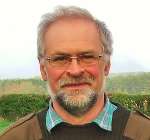Commercial Christmas seems to start earlier year on year, with Perth mirroring other cities turning on sparkly illuminations in mid-November. Keeping the solemn season of Advent has almost become subversive, yet judging by the large audience filling the beautiful St John's Kirk, there is a need to step back from the day-to-day into the contemplative. With the days still shortening and temperatures falling, the Scottish Ensemble’s soulful ancient and modern programming, Musica Adventus on unusual Christmas themes, provided welcome space to free the imagination.
Gabrieli’s Canzon duodecimi toni, à 10 was a bright opener, played with the ensemble arranged across the front of the platform and split into two groups. Each exchanged the light and rhythmic intertwining lines, becoming like an ancient dance when joined by a tambourine. This early-Baroque first half featured two Christmas Concertos: the first, Torelli’s Concerto grosso in G minor “Per il Santissimo Natale” (for the Holy Christmas) saw the Ensemble conjure slow, stately themes in a delicate, gentle pastoral feel, moving briskly on with intense excitement and glittering violin playing as individual players across the group took their moment to shine. Corelli’s “Christmas” Concerto Grosso no. 8, made of five linked movements, was a piece of striking contrasts, the serious scene-setting tone evolving to a lively opening movement underpinned with an astonishing fingering workout for the fast-moving continuo. It was fun to watch the players getting the most out of the piece with playful accents and dynamic changes, yet the work ended quietly with the Christmas shepherds in a swaying Pastorale, Tom Foster’s harpsichord adding frosty sparkle.
Guitarist Sean Shibe appeared for a solo performance of Kapsberger’s Toccata arpeggiata, all softly flowing broken chords, joining the group for Vivaldi’s Concerto for lute and 2 violins in D major, the Ensemble in a supportive role carefully balancing the sound while maintaining lively excitement in the outer movements. The slow Largo was especially effective, with Shibe’s guitar dreamily floating out high notes over wistful long-bowed strings, a touch of melancholy before the energetic final movement arrived, with its playful exchanges between soloist and ensemble and busy continuo.
In the centre of the Baroque programme, a magical surprise: while the main quartet played Bach’s “deathbed” Chorale Prelude from The Art of Fugue, the other players softly sang the chorale, Diane Clark picking up her bass to provide gravity in the final bars.
The modern second half was bookended by the thought-provoking first and last movements of Pēteris Vasks’ Musica Adventus, an arrangement of his third string quartet, inspired by the idea of "Christmas, Peace on Earth", the work at the very heart of this concert. Using carol themes, the music dipped and surged with juxtaposition of harsh con legno work with rich harmonies in the lower strings. The final movement used high hushed harmonics intertwined with themes which built to a frenzy before dying away into the ether, leader Jonathan Morton producing a wintery feel in a work that seeks to be joyful, but is peppered with a restless unease.
Holst’s Intermezzo from his St Paul’s Suite allowed the Ensemble to embrace the full pastoral: an Eastern-influenced soaring solo violin over pizzicato strings was joined by a viola setting the music scampering off, resolving in a slow, strong unison theme, the players jumping effortlessly through the series of contrasts. Shibe re-joined the forces for Malcolm Arnold’s beautiful Serenade for Guitar and Strings, his instrument softly playing over muted strings, alternating the dreamy theme with more energetic passages, before ending with use of harmonics over hushed accompaniment.
The second half’s centrepiece was a performance of Sally Beamish’s Under the Wing of the Rock, a work commissioned by the Ensemble with violist Lawrence Power some years ago, and inspired by the haunting scene of a young mother singing to her child as they fled the Glencoe massacre. Jane Atkins took centre stage, her rich soulful viola playing a slow, haunting tune, heavy with yearning and full of expression, wonderfully atmospheric in the candlelit kirk. In the central passage, the music turned wild in a chase with Gaelic rhythms and chants, Morton keenly urging his players on before harmonious calm descended with a return of Atkins’ softly soaring viola. Although perhaps the least seasonal piece, it was the one that provided most room for reflective thought at this special time of year.


